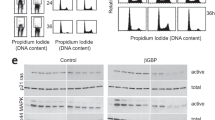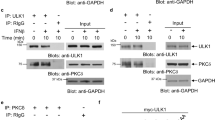Abstract
THE interferons were originally described as proteins, produced by cells in response to virus infection, which could induce viral resistance in cells of the same species1. It is becoming clear that these proteins have other important biological activities2 and can inhibit cell division in both normal and malignant cells3–5. Although the phenomenon of growth inhibition by interferon is well established, data analysis of the effect in terms of the cell cycle is limited and not completely consistent. Killander et al.6 and Matarese and Rossi7, using asynchronously growing cultures of L1210 and Friend leukaemia cells respectively, have found that interferon-treated cells are delayed in both G1 and G2, and we have recently observed a similar effect of interferon on asynchronously growing MCF-7 cells8. Sokawa et al. have reported, however, that the only parameter affected in interferon-treated quiescent BALB/c 3T3 cells after serum stimulation, is their rate of entry into S (ref. 9). It is possible that the effect of interferon on the cell cycle of asynchronous transformed cells is different, in terms of cell cycle parameters, from its effect on quiescent untransformed cells. In an attempt to clarify this point, we have examined in detail the effect of interferon on the passage of serum-stimulated cells through the cell cycle, using BALB/c 3T3 and Swiss 3T3K cells, and a strain of human embryo lung diploid fibroblasts, HEL 27. In contrast to Sokawa et al., we have found that both G1 and S+G2 are extended by interferon treatment of all three cell types studied.
This is a preview of subscription content, access via your institution
Access options
Subscribe to this journal
Receive 51 print issues and online access
$199.00 per year
only $3.90 per issue
Buy this article
- Purchase on Springer Link
- Instant access to full article PDF
Prices may be subject to local taxes which are calculated during checkout
Similar content being viewed by others
References
Isaacs, A. & Lindenmann, J. Proc. R. Soc. B 147, 258–267 (1957).
Gresser, I. Cell. Immun. 34, 406–415 (1977).
Paucker, K., Cantell, K. & Henle, W. Virology 17, 324–334 (1962).
Balkwill, F. R. & Oliver, R. T. D. Int. J. Cancer 20, 500–505 (1977).
Strander, H. & Einhorn, S. Int. J. Cancer 19, 468–473 (1977).
Killander, D., Lindahl, P., Lundin, L., Leary, P. & Gresser, I. Eur. J. Immun. 6, 56–59 (1976).
Matarese, G. & Rossi, G. J. Cell Biol. 75, 344–354 (1977).
Balkwill, F., Watling, D. & Taylor-Papadimitriou, J. Int. J. Cancer (in the press).
Sokawa, Y., Watanabe, Y., Watanabe, Y. & Kawade, Y. Nature 268, 236–238 (1977).
Smith, J. & Martin, L. Proc. natn. Acad. Sci. U.S.A. 70, 1263–1267 (1973).
Taylor-Papadimitriou, J., Stoker, M. & Riddle, P. Int. J. Cancer 7, 269–276 (1971).
Havell, E. A., Yip, J. K. & Vilcek, J. J. gen. Virol. 38, 51–59 (1977).
Author information
Authors and Affiliations
Rights and permissions
About this article
Cite this article
BALKWILL, F., TAYLOR-PAPADIMITRIOU, J. Interferon affects both G1 and S+G2 in cells stimulated from quiescence to growth. Nature 274, 798–800 (1978). https://doi.org/10.1038/274798a0
Received:
Accepted:
Issue Date:
DOI: https://doi.org/10.1038/274798a0
Comments
By submitting a comment you agree to abide by our Terms and Community Guidelines. If you find something abusive or that does not comply with our terms or guidelines please flag it as inappropriate.



